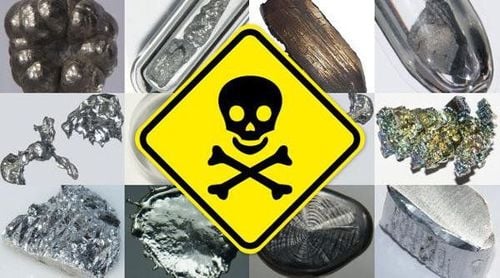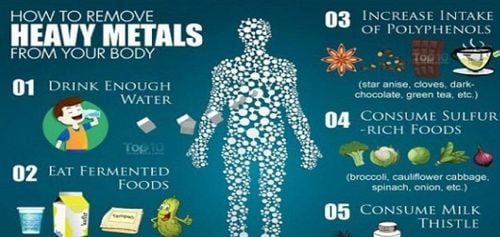This is an automatically translated article.
Cadmium has the most extensive distribution of the six heavy metals (lead, cadmium, mercury, zinc, arsenic and selenium) and mercury the most limited. The mean intakes of lead, cadmium and mercury are lower than the WHO/FAO acceptable intakes for adults, but have not been established for arsenic and selenium. However, an increase in the concentration of these elements in food would be considered undesirable.
1. Heavy metals in food
Metals - both beneficial and harmful - are found in many foods. Because our air, water, and soil all contain metals (and the elements that combine metals and non-metals are called metals). Levels of heavy metals found in foods or heavy metals in seafood depend on many factors, including: Growing conditions; industrial, manufacturing and agricultural processes; DNA of food crops; and environmental pollution in the past or present. Additionally, some metals that the human body needs, such as iron, are intentionally added to certain foods, including breakfast cereals and baby formula, to enhance the benefits. for their diet.
2. The key to a well-balanced diet
The key to a well-balanced diet is to eat a variety of healthy foods. To keep the U.S. food supply among the safest in the world, the Food and Drug Administration (FDA) oversees and inspects food and sets standards. to ensure appropriate and safe levels of beneficial metals and to limit harmful metals in food to the most realistic levels. The Food and Drug Administration (FDA) also monitors and regulates metal levels in animal feed and cosmetics. The Food and Drug Administration (FDA) uses its authority to take action on a case-by-case basis when levels of metals in FDA-regulated products are determined to be not safe.
The characteristics of specific heavy metals, intake, age and stage of development are all key factors that help determine how metals affect individual health. Even health-promoting metals can be harmful if exposed in excess of recommended doses. For example, iron is an essential dietary metal, and although the body regulates iron absorption to help protect against overeating, iron poisoning can still occur, usually from ingestion. too many iron supplements. Symptoms can include severe vomiting, diarrhea, abdominal pain, dehydration, and coma if not treated properly.
Some metals, such as arsenic, lead and mercury, are not healthy, and have been shown to lead to illness, weakness and, in high doses, death. Understanding the risk that harmful metals pose in our food supply is complicated by the fact that no single food source accounts for most people's exposure to metals in food. Human exposure comes from a variety of foods that contain these metals. Incorporating all the foods we eat, even low levels of harmful metals from individual food sources, can sometimes raise worrying levels.

Để hạn chế kim loại nặng đi vào cơ thể, nên có một chế độ ăn uống cân bằng và lành mạnh.
3. Food and Drug Administration FDA Working Group on Toxic Factors
The agency's Toxic Factors Working Group (TEWG) aims to reduce exposure to toxic elements in food, cosmetics and dietary supplements. This team includes senior leaders and risk managers at the Center for Food Safety and Applied Nutrition (CFSAN) with experience in microbiology, toxicology, chemistry, medicine, and epidemiology. epidemiology, policy and law. Working with scientists across the Center, the team is addressing the issues presented by metals with the following approach:
Prioritize metals by toxicity and prevalence - The team is looking at the presence presence of metals in all regulated CFSAN products and identifies areas where FDA can have the greatest impact on reducing exposure. The working group is focusing first on: Lead, arsenic, cadmium and mercury in foods, cosmetics and dietary supplements, because high levels of exposure to those metals are likely to have the most significant impact. to public health. It was essential to make it a priority to study the vast amount of data that we had collected over the years. The Food and Drug Administration (FDA) has been collecting data on contaminants and nutrients in food for decades as part of its Total Diet Study. The study regularly samples products found in grocery stores around the country, testing for hundreds of contaminants, including these metals. These data are important because they can help us better understand how consumers are exposed to these pollutants.
Identify the most vulnerable populations - Those most vulnerable to the harmful effects of metals in food include infants and children, the elderly and consumers who may have chronic illnesses. As the agency works to reduce consumer exposure to metals through food and other products, we're paying special attention to children because of their smaller body size and metabolism. Their properties may make them more susceptible to the harmful effects of these metals. Of particular concern is the effect of these metals on the neurological development of children.
Identify effective ways to reduce exposure – FDA is committed to using the best available science to inform and support policy decisions about toxic metals. FDA will review a range of policies and actions to reduce exposure, from requiring or encouraging industry to take steps to reduce the presence of metals in products to educating consumers about how to they can reduce the risk posed by these metals.

Những người dễ bị ảnh hưởng bởi tác hại của kim loại nặng trong thực phẩm bao gồm trẻ sơ sinh, trẻ em, người già.
4. FDA Monitoring and Testing for Metals and Other Elements
Food and Drug Administration FDA monitors levels of metals and other elements in foods and food contact surfaces to inform and enforce FDA rules and guidelines. FDA tests for metals and other elements through the Total Dietary Study; FDA Toxic Factors in Food and Feed; and radionuclides in the food compliance program; and through targeted sampling missions. Sampling assignments can be conducted according to reports of high levels of toxic metals or other elements in certain foods or to focus on a specific food, food additive or specific food groups (such as foods that babies and toddlers usually eat).
Metals examined in the FDA Dietary Overall Study: Calcium, Chromium, Copper, Iron, Magnesium, Manganese, Molybdenum, Potassium, Sodium, Zinc
Metals with daily intake requirements Metals Harmful to Health: Aluminum, Antimony, Arsenic, Barium, Beryllium, Cadmium, Lead, Mercury, Silver, Strontium, Nickel, Thallium, Uranium, Vanadium
FDA experts involved in the agency international standard-setting, Codex Alimentarius CommissionExternal Link Disclaimer (Codex). Codex's purpose is to protect the health of consumers and promote fair trade practices by applying science-based standards, guidelines, and codes of practice across all areas of quality. quality and food safety. Its work includes reviewing scientific data regarding arsenic and metal contamination levels in water and food. These international discussions can lead to recommendations on applicable national standards and codes of practice.
Please dial HOTLINE for more information or register for an appointment HERE. Download MyVinmec app to make appointments faster and to manage your bookings easily.
References: fda.gov, ncbi.nlm.nih.gov












